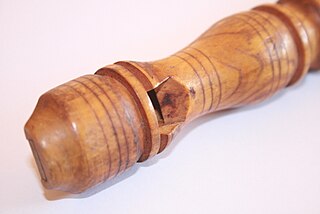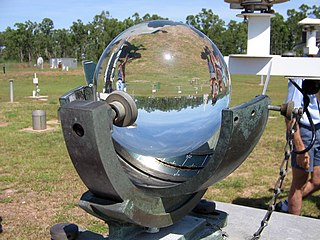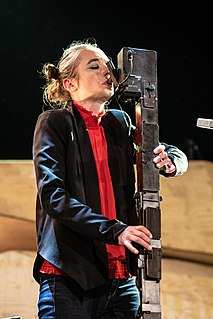Related Research Articles

Bass ( BAYSS) (also called bottom end) describes tones of low (also called "deep") frequency, pitch and range from 16 to 256 Hz (C0 to middle C4) and bass instruments that produce tones in the low-pitched range C2-C4. They belong to different families of instruments and can cover a wide range of musical roles. Since producing low pitches usually requires a long air column or string, and for stringed instruments, a large hollow body, the string and wind bass instruments are usually the largest instruments in their families or instrument classes.

The recorder is a family of woodwind musical instruments in the group known as internal duct flutes: flutes with a whistle mouthpiece, also known as fipple flutes. A recorder can be distinguished from other duct flutes by the presence of a thumb-hole for the upper hand and seven finger-holes: three for the upper hand and four for the lower. It is the most prominent duct flute in the western classical tradition.

Woodwind instruments are a family of musical instruments within the greater category of wind instruments. Common examples include flute, clarinet, oboe, bassoon, and saxophone. There are two main types of woodwind instruments: flutes and reed instruments. The main distinction between these instruments and other wind instruments is the way in which they produce sound. All woodwinds produce sound by splitting the air blown into them on a sharp edge, such as a reed or a fipple. Despite the name, a woodwind may be made of any material, not just wood. Common examples include brass, silver, cane, as well as other metals such as gold and platinum. The saxophone, for example, though made of brass, is considered a woodwind because it requires a reed to produce sound. Occasionally, woodwinds are made of earthen materials, especially ocarinas.

A clef is a musical symbol used to indicate which notes are represented by the lines and spaces on a musical stave. Placing a clef on a stave assigns a particular pitch to one of the five lines, which defines the pitches on the remaining lines and spaces.

An aerophone is a musical instrument that produces sound primarily by causing a body of air to vibrate, without the use of strings or membranes, and without the vibration of the instrument itself adding considerably to the sound.

Aeroperú Flight 603 was a scheduled passenger flight from Miami International Airport in Miami, Florida, US (KMIA), to Comodoro Arturo Merino Benítez International Airport in Santiago, Chile (SCEL), with stopovers in Quito, Ecuador and Lima, Peru. On October 2, 1996, the Boeing 757-23A aircraft flying the final leg of the flight crashed, killing all 70 people aboard.
Contrabass refers to several musical instruments of very low pitch—generally one octave below bass register instruments. While the term most commonly refers to the double bass, many other instruments in the contrabass register exist.

The term fipple specifies a variety of end-blown flute that includes the flageolet, recorder, and tin whistle. The Hornbostel–Sachs system for classifying musical instruments places this group under the heading "Flutes with duct or duct flutes." The label "fipple flute" is frequently applied to members of the subgroup but there is no general agreement about the structural detail of the sound-producing mechanism that constitutes the fipple, itself.

A flight recorder is an electronic recording device placed in an aircraft for the purpose of facilitating the investigation of aviation accidents and incidents. The device may often be referred to as a "black box", an outdated name which has become a misnomer—they are now required to be painted bright orange, to aid in their recovery after accidents.

A data logger is an electronic device that records data over time or about location either with a built-in instrument or sensor or via external instruments and sensors. Increasingly, but not entirely, they are based on a digital processor, and called digital data loggers (DDL). They generally are small, battery-powered, portable, and equipped with a microprocessor, internal memory for data storage, and sensors. Some data loggers interface with a personal computer and use software to activate the data logger and view and analyze the collected data, while others have a local interface device and can be used as a stand-alone device.

A chart recorder is an electromechanical device that records an electrical or mechanical input trend onto a piece of paper. Chart recorders may record several inputs using different color pens and may record onto strip charts or circular charts. Chart recorders may be entirely mechanical with clockwork mechanisms, electro-mechanical with an electrical clockwork mechanism for driving the chart, or entirely electronic with no mechanical components at all.

The Campbell–Stokes recorder is a type of sunshine recorder. It was invented by John Francis Campbell in 1853 and modified in 1879 by Sir George Gabriel Stokes. The original design by Campbell consisted of a glass sphere set into a wooden bowl with the sun burning a trace on the bowl. Stokes's refinement was to make the housing out of metal and to have a card holder set behind the sphere.

In music, the bore of a wind instrument is its interior chamber. This defines a flow path through which air travels, which is set into vibration to produce sounds. The shape of the bore has a strong influence on the instrument's timbre.

Sopilka is a name applied to a variety of woodwind instruments of the flute family used by Ukrainian folk instrumentalists. Sopilka most commonly refers to a fife made of a variety of materials and has six to ten finger holes. The term is also used to describe a related set of folk instruments similar to recorder, incorporating a fipple and having a constricted end.

The great bass recorder is a member of the recorder family. With the revival of the recorder by Arnold Dolmetsch, who chose Baroque music and the corresponding recorder types as a fixed point, consideration was given to the design of recorder types larger than the bass recorder. The great bass recorder has up to seven keys, which serve to facilitate access to the finger holes. For modern large bass recorders woods like maple or African Bubinga are used. The term usually applies to an instrument with range is c–d2 (g2), but has also been used to describe an instrument descending to B♭ or else to the low bass recorder in F, alternatively known as a contrabass. When "great bass" is used for the instrument in low F, the instruments in C and B♭ are referred to as "quart-bass" and "quint-bass", respectively, because they are a fourth and fifth below the ordinary small bass, or "basset". The prefixes "great" and "contra" refer to the registers from C to B and from ͵C to ͵B, respectively, in Helmholtz pitch notation.

EastWest Studios is a recording studio complex located at 6000 West Sunset Boulevard in Hollywood. Originally constructed by Bill Putnam in the 1960s, the studios are currently owned by sound developer Doug Rogers and managed by Candace Stewart.
Musical instruments used in Baroque music were partly used already before, partly are still in use today, but with no technology. The movement to perform music in a historically informed way, trying to recreate the sound of the period, led to the use of historic instruments of the period and to the reconstruction of instruments.
Sunshine duration or sunshine hours is a climatological indicator, measuring duration of sunshine in given period for a given location on Earth, typically expressed as an averaged value over several years. It is a general indicator of cloudiness of a location, and thus differs from insolation, which measures the total energy delivered by sunlight over a given period.

The sub-great bass recorder, also known as contra great bass and contrabass, is a recorder with the range C–d1 (g1). It is manufactured in both bent ("knick") and square designs. The design with a square or rectangular cross-sections was first patented in 1975 by Joachim and Herbert Paetzold. They are made from plywood and have a doubled-back bore like a bassoon, which reduces the exterior length of the instrument. They also have wooden keys. Through this special and proprietary design, the instrument can be played with a very short bocal.

The contrabass or great bass recorder is a wind instrument in F2 that belongs to the family of recorders.
References
- ↑ Lasocki, David (2001). "Recorder". In Sadie, Stanley; Tyrrell, John (eds.). The New Grove Dictionary of Music and Musicians (2nd ed.). London: Macmillan. ISBN 9780195170672.